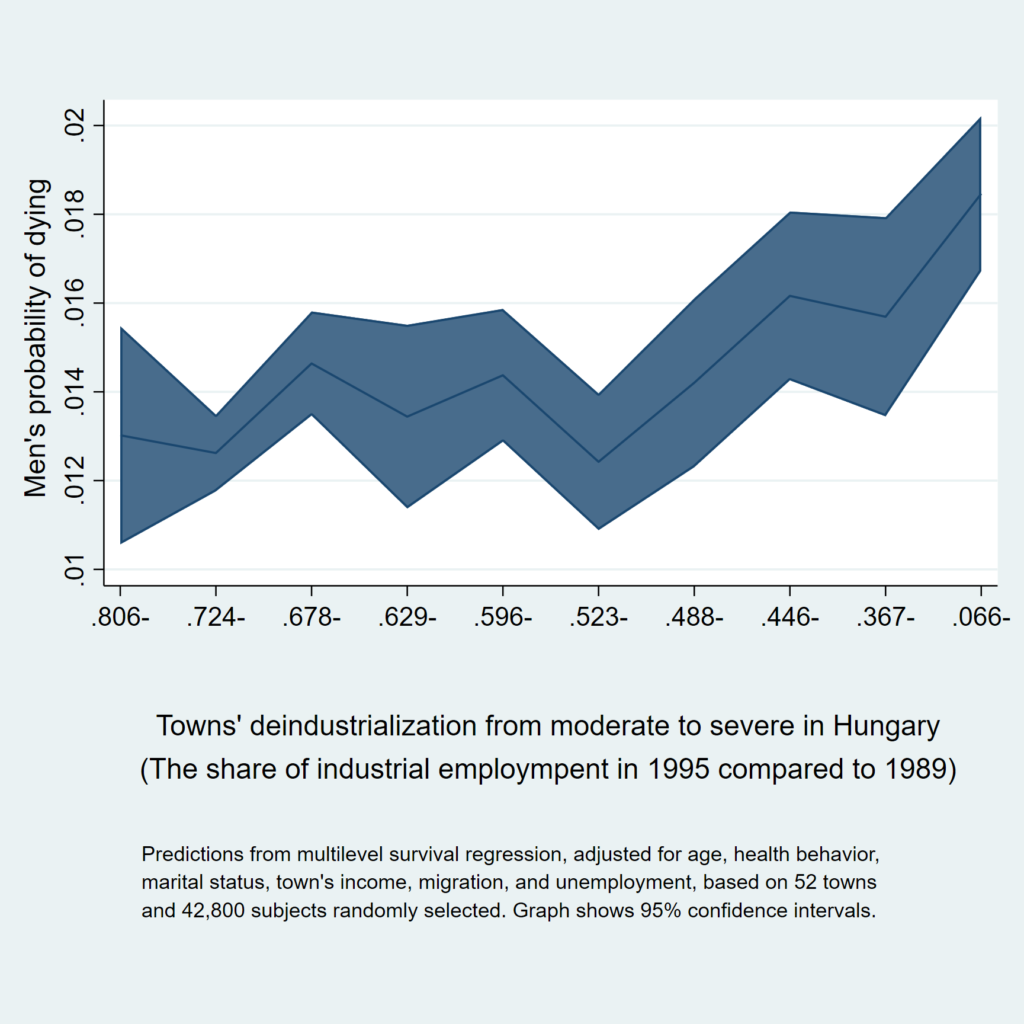Surviving and dying are life chances in the most profound sense, a truism that the corona pandemic has powerfully underpinned. Already before the pandemic hit, the declining life expectancy in deindustrialized, rustbelt areas and the accompanying deepening of health inequalities have been signaling the existential crisis of contemporary economic arrangements. Recent research by Ann Case and Nobel-laurate economist Angus Deaton has generated wide attention to workers’ declining health in the North American Rust Belt, igniting the “deaths of despair” debate (Case and Deaton 2020).

Case and Deaton argue that this mortality crisis is driven by deindustrialization, which represents one of the crucial “faults of contemporary capitalism” that are “widespread, and America is simply the leader of a more general disaster that is already taking root elsewhere.” The U.S. is indeed not alone. The post-socialist mortality crisis offers insightful parallels. Foreshadowing today’s working-class epidemic of deaths of despair, an unprecedented mortality crisis hit Eastern Europe 30 years ago as ex-socialist countries transitioned to capitalism.
The number of excess deaths could have been around 7.3 million in Eastern Europe in 1991-1999, out of this 5 million in Russia according to David Stuckler (2009); an estimate that falls in-between the UNICEF’s smaller figure of 3.3 million for Eastern Europe (UNICEF 2001) and much larger estimates of as much as 6.1 million excess deaths in Russia alone (Rosefielde 2001). Even though life expectancy has improved after the tumultuous years of the early 1990s, the post-socialist mortality crisis has left lasting wounds on post-socialist countries, contributing to deep health inequalities that continue to exist until today. It represents one of the largest demographic catastrophes seen outside famine or war in recent history (Eberstadt 2010). As Case and Deaton (2020:108) highlight, “it is no exaggeration to compare the long-standing misery of these Eastern Europeans with the wave of despair that is driving suicides, alcohol, and drug abuse among less-educated white Americans.”
What explains the post-socialist mortality crisis?
The causes are manifold. In a stream of studies emerging out of the Privatization and Mortality research project (see Irdam et al 2016 and Scheiring et al 2020a for an overview of the methodology and project design), we shed light on the underlying economic causes. Our literature reviews show (Scheiring et al 2018b, Scheiring et al 2019) that researchers agree that the post-socialist mortality crisis was not a crisis related to the health care system, pollution, or deep-poverty-related malnutrition; all these problems would have struck the most vulnerable, the elderly, the young. The profile of the post-socialist mortality crisis shows the centrality of stress and despair that plagued mid-aged working-class men without a college degree, who died in increasing numbers because of suicide, mental disorders, heart attacks, and alcohol abuse.
Researchers agree that hazardous alcohol consumption was a crucial proximal cause of excess postsocialist deaths. Hazardous drinking increased strokes, infarctions, cirrhosis, and accidents. Social epidemiologists and sociologists agree that the transition from state socialism to capitalism was a particularly stressful instance of institutional change, contributing to hazardous drinking as a negative stress-coping strategy (Perlman and Bobak 2009: 1818; Walberg et al. 1998).
However, there is a fierce disagreement about the upstream economic causes. Some argue that economic dislocation caused stress and despair, leading to adverse health behavior and ill health. For example, in Hungary, between 1988 and 1995, almost every second (!) person employed in the industry lost their job. That is more than 40% deindustrialization over seven years; nowhere else in the world will you find such a rapid collapse of industry. At the same time, in the early 1990s, Hungary had one of the most developed welfare regimes in the region, saving many lives. Others suggest that economic and social policies had nothing to do with these deaths and that hazardous drinking inherited as part of a dysfunctional working-class culture and populist alcohol policy were the key determinants (Bhattacharya 2013, Treisman 2010).
A pioneering and often-cited study argued that mass privatization was a crucial economic policy factor driving excess deaths in Russia (Stuckler et al. 2009). However, economists quickly attacked this argument (Earle and Gehlbach 2010). In response, we launched the Privatization and Mortality project, using a quasi-experimental design. In one of the studies, we show that prolonged state ownership appears to have been health-protective compared to privatization in Hungary (Scheiring et al 2018a). We collected multilevel data related to Hungary between 1995 and 2004 at the town, company, and individual level to assess the relationship between the dominant company ownership of a town and mortality. We grouped towns into three ownership categories: dominant state, domestic private, and foreign ownership. We did population surveys in these towns to collect data on vital status and other characteristics of survey respondents’ relatives. We collected data on 78 622 individuals from the 52 towns, of whom 27 694 were considered eligible. We assessed the relation between dominant ownership and mortality at the individual level. We used discrete-time survival modeling, adjusting for town-level and individual-level confounders. After multivariable adjustment, we found that women living in towns with prolonged state ownership had significantly lower odds of dying than women living in towns dominated by domestic private ownership. Women were overrepresented in sectors with prolonged state ownership compared to the general population, which could explain this gendered effect of privatization.
In another study, based on surveys of individuals nested in a matched set of towns with and without mass privatization in Russia, we confirmed the association between mass privatization and mortality (Azarova et al 2017). We surveyed surviving relatives of individuals who lived through the post-communist transition to retrieve their parents, siblings, and male partners’ demographic and socioeconomic characteristics. We surveyed relatives in 20 mono-industrial towns in the European part of Russia. We compared ten fast-privatized and ten slow-privatized towns selected using propensity score matching. In the selected towns, population surveys were done in which respondents provided information about vital status, sociodemographic and socioeconomic characteristics, and health-related behaviors of their relatives. We calculated indirect age-standardized mortality rates in fast and slow privatized towns and then, in multivariate analyses, calculated Poisson proportional incidence rate ratios to estimate the effect of rapid privatization on all-cause mortality risk. We found that fast privatization was indeed strongly associated with higher working-age male mortality rates
In a recently published working paper, we show that deindustrialization could have been another crucial determinant (Scheiring et al 2021). We rely on a novel multilevel dataset, fitting survival and two-way fixed effects panel models covering 52 towns and 42,800 people in 1989-1995 in Hungary and 514 medium-sized towns in the European part of Russia. The results show that deindustrialization was significantly associated with male mortality in both countries directly and indirectly mediated by adverse health behavior (alcohol abuse) as a dysfunctional stress-coping strategy. Both countries experienced severe deindustrialization, but social policies seem to have offset the adverse health effect of Hungary’s more immense industrial employment loss. Besides, Russia’s botched rapid mass privatization program made the mortality crisis significantly worse than in countries – such as Hungary – with more gradual privatization.

In a related study, we also demonstrate that the arguments that want to reduce the post-socialist mortality crisis to misguided alcohol policy and dysfunctional working-class drinking culture do not withstand empirical scrutiny (Azarova et al 2021). Alcohol abuse was primarily a result of the stress created by economic dislocation, and not populist alcohol policy, the end of the Gorbachev anti-alcohol campaign, or the relative drop in vodka price in Russia, as some economists suggested (Bhattacharya 2013, Treisman 2010). In contrast, our findings linking privatization to mortality are robust to controlling for the anti-alcohol campaign and the affordability of alcohol.
Finally, a related, also recently published working paper based on 82 life history interviews with workers in Hungary’s rustbelt maps the mechanisms that link upstream economic dislocation to individual health problems through community destruction, inequality, precarity, and the destruction of services (Scheiring et al 2020b). Deindustrialization engenders individual and social processes that affect health by increasing stress and eroding coping resources. By conceptualizing deindustrialization as a fundamental cause of ill health, economic sociology and political economy have a great potential to contribute to better, evidence-based policies to improve population health by reducing the underlying economic tensions.
Durkheim (2002[1897]: 207) famously concluded that ‘whenever serious readjustments take place in the social order, whether or not due to a sudden growth or an unexpected catastrophe, men are more inclined to self-destruction.’ Engels (2009[1845]: 106) captured another way in which economic change can lead to mortality: ‘[W]hen society places hundreds of proletarians in such a position that they inevitably meet a too early and an unnatural death; when it deprives thousands of the necessaries of life, places them under conditions in which they cannot live, and yet permits these conditions to remain, its deed is murder.’ The post-socialist mortality crisis of the 1990s and today’s working-class deaths of despair epidemic are proof of these bold early insights.
Only equally bold analyses and policies can prevent similar excess deaths in the future. Social and economic policies addressing the underlying causes of stress and despair can improve health and save lives.
As part of a cooperation between Eastern European leftist media platforms in ELMO (East Left Media Outlet) the article was translated to Romanian at Platzforma and Baricada.
References
Azarova, Aytalina, et al. (2017), ‘The effect of rapid privatization on mortality in mono-industrial towns in post-Soviet Russia: a retrospective cohort study’, The Lancet Public Health, 2 (5), e231-e38.
Azarova, Aytalina, et al. (2021), ‘Did Alcohol Policy Really Cause the Postsocialist Mortality Crisis? Revisiting the Rebound and Affordability Hypotheses’, (University of Massachusetts, Amherst: Political Economy Research Institute (PERI), Working Paper Series, Number 540).
Bhattacharya, Jay, Gathmann, Christina, and Miller, Grant (2013), ‘The Gorbachev Anti-Alcohol Campaign and Russia’s Mortality Crisis’, American Economic Journal: Applied Economics, 5 (2), 232-60.
Case, Anne and Deaton, Angus (2020), Deaths of Despair and the Future of Capitalism (Princeton: Princeton University Press).
Durkheim, Émile (2002[1897]), Suicide: A study in sociology (London & New York: Routledge Classics).
Earle, John S. and Gehlbach, Scott (2010), ‘Did mass privatization really increase post-communist mortality?’, The Lancet, 375 (9712), 372.
Eberstadt, Nicholas (2010), ‘The Enigma of Russian Mortality’, Current History, 109 (729), 288.
Engels, Friedrich (2009[1845]), The Condition of the Working-Class in England (Oxford: Oxford University Press).
Irdam, D., et al. (2016), ‘Mortality in Transition: A Multilevel Indirect Demographic Cohort Study PrivMort’, BMC Public Health, 16 (672), 1-8.
Perlman, Francesca and Bobak, Martin (2009), ‘Assessing the Contribution of Unstable Employment to Mortality in Posttransition Russia: Prospective Individual-Level Analyses From the Russian Longitudinal Monitoring Survey’, American Journal of Public Health, 99 (10), 1818-25.
Rosefielde, Steven (2001), ‘Premature Deaths: Russia’s Radical Economic Transition in Soviet Perspective’, Europe-Asia Studies, 53 (8), 1159-76.
Scheiring, Gábor, et al. (2018a), ‘The gendered effects of foreign investment and prolonged state ownership on mortality in Hungary: an indirect demographic, retrospective cohort study’, The Lancet Global Health, 6 (1), 95-102.
Scheiring, Gábor, et al. (2018b), ‘The wounds of post-socialism: a systematic review of the social determinants of mortality in Hungary’, Journal of Contemporary Central and Eastern Europe, 26 (1), 1-31.
Scheiring, Gábor, et al. (2019), ‘Cross-Country Evidence on the Social Determinants of the Postsocialist Mortality Crisis in Europe: A Review and Performance-Based Hierarchy of Variables’, Sociology of Health & Illness, 41 (4), 673-91.
Scheiring, Gábor, et al. (2020a), ‘Analyzing the Health Impact of Economic Change: Insights From a Multilevel Retrospective Cohort Study’, (doi: https://dx.doi.org/10.4135/9781529711189: SAGE Research Methods Cases: Medicine and Health).
Scheiring, Gábor, et al (2020b), ‘Deindustrialization and deaths of despair: mapping the impact of industrial decline on ill health’, (University of Massachusetts, Amherst: Political Economy Research Institute (PERI), Working Paper Series, Number 530, November 30, 2020).
Scheiring, Gábor, et al. (2021), ‘Deindustrialization and the Postsocialist Mortality Crisis’, (University of Massachusetts, Amherst: Political Economy Research Institute (PERI), Working Paper Series, Number 541, April 2021).
Stuckler, David (2009), ‘Social Causes of Post-Communist Mortality: A Macro-Sociological Analysis [dissertation]’, (Cambridge, UK: University of Cambridge).
Stuckler, David, et al. (2009), ‘Mass privatization and the post-communist mortality crisis: a cross-national analysis’, The Lancet, 373 (9661), 399-407.
Treisman, Daniel (2010), ‘Death and prices: The political economy of Russia’s alcohol crisis’, Economics of Transition, 18 (2), 281-331.
Walberg, Peter, et al. (1998), ‘Economic change, crime, and mortality crisis in Russia: regional analysis’, BMJ, 317 (7154), 312-18.

Gabor Scheiring (PhD, Cambridge), former member of the Hungarian Parliament (2010-2014), is a Marie Curie Fellow at Bocconi University. Utilizing methods and insights from sociology, economics, political science, and epidemiology, he researches the social consequences of globalization and the political economy of health and democracy. His book, The Retreat of Liberal Democracy (Palgrave, 2020) shows how working-class dislocation and business elite polarization enabled illiberalism in Hungary.

